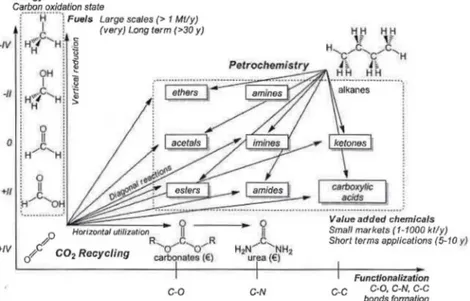HAL Id: cea-02341645
https://hal-cea.archives-ouvertes.fr/cea-02341645
Submitted on 31 Oct 2019
HAL is a multi-disciplinary open access
archive for the deposit and dissemination of
sci-entific research documents, whether they are
pub-lished or not. The documents may come from
teaching and research institutions in France or
abroad, or from public or private research centers.
L’archive ouverte pluridisciplinaire HAL, est
destinée au dépôt et à la diffusion de documents
scientifiques de niveau recherche, publiés ou non,
émanant des établissements d’enseignement et de
recherche français ou étrangers, des laboratoires
publics ou privés.
Activation and Conversion of C0_2 and S0_2 under
Metal-Cree Conditions
T. Cantat
To cite this version:
T. Cantat. Activation and Conversion of C0_2 and S0_2 under Metal-Cree Conditions. ESOC 2017,
Jul 2017, Cologne, Germany. �cea-02341645�
Activation and Conversion
oC
C02
and
S02
under Metal-Cree Conditions
T. Cantat
NIMBE.
CEA. CNRS. Université Paris-Saclay.
91191 Gif-sur-Yvette. France
e-mail: thibault.cantat@cea.fr
With 95 % of organic chemical commodities deriving from fossi! resources, the chemical industry
is currently exploring novel and renewable carbon feedstocks for the production of both bulk and fine
chemicals
.
1In this context, the utilization of C02 or products derived from biomass wastes is an
attractive strategy to access value-added products. Because these carbon sources feature carbon atoms in
an
oxidized state, the developmenti,of reduction methods is needed and they call for the design of
efficient
catalysts
able to break
strongT~Oand C=O bonds.
Over the last years, our group has developed novel catalytic reactions for the conversion of C02 to
formamides
,
N-heterocyc\es, methylamines and methanol, using hydroboranes, hydrosilanes or formic
acid as reductants.
2-16Extension ofthis methodology to S02 enabled the facile conversion ofthis gaz to
sulfones, under metal-free conditions Y These new catalytic transformations rely on the use of simple
organocatalysts, inc\uding nitrogen and phosphorus bases as weil as Frustrated Lewis Pairs. The
mechanisms at play in these transformations will be presented, based on DFT calculations and isolation
of reactive catalytic intermediates
.
Energy
Carbon oxidation state
f-"-~""! Fuels Large scales (> 1 Mt/y)
!
c
;
(very) Long tarm (>30 y)-IV ; H~\~ ... H
:
gi
Hl
i
!
OH ; -, 1 : a; -II : C'
~
r
H""
'H
'
::.
1.
H '!
Petrochemistry !?t
i
o
1 ,.. :iH
...
'
H
!
: 1 +/1i
~
l
~/C'o~··
..
...
·:
~~~==~
Ç;o
-=-=
-_
HOflzonta' utlllzat/on Il ..g
R,O-,C,O ... R H N ... 'NH carbonatl" (€) 2 urea (€)' 2 +/vof'
cf?
CO2 Recycling C-Q C·N C·C Functionalizalion C·Q, C-N, C·G bonds formationReferences
1. C. Chauvier, T. Cantat, ACS Catalysis 2017,7,2107-2115.
2. C. D. Gomes, O. Jacquet, C. Villiers, P. Thuery, M. Ephritikhine, T. Cantat, Angewandte Chemie-International
Edition 2012, 51,187-190.
3. O. Jacquet, X. Frogneux, C. D. Gomes, T. Cantat, Chemica/ Science 2013,4,2127-2131. 4. O. Jacquet, C. D. Gomes, M. Ephritikhine, T. Cantat, Chemcatchem 2013, 5, 117-120. 5. X. Frogneux, O. Jacquet, T. Cantat, Catalysis Science & Technology 2014,4, 1529-1533.
6. C. D. Gomes, E. Blondiaux, P. Thuery, T. Cantat, Chemistry-a European Journal 2014, 20, 7098-71 06.
7. A. Tlili, X. Frogneux, E. Blondiaux, T. Cantat, Angewandte Chemie-Intemational Edition 2014, 53, 2543-2545. 8. C. Chauvier, A. Tlili, C. D. Gomes, P. Thuery, T. Cantat, Chemical Science 2015,6,2938-2942.
9. X. Frogneux, E. Blondiaux, P. Thuery, T. Cantat, ACS Catalysis 2015, 5, 3983-3987. 10. A. TliIi, E. Blondiaux, X. Frogneux, T. Cantat, Green Chemistry 2015,17,157-168.
11. A. Aloisi, J. C. Berthet, C. Genre:'P. Thuery, T. Cantat, Dalton Transactions 2016, 45,14774-14788.
12. X. Frogneux, N. von Wolff, P. Thuery., G. Lefevre, T. Cantat, Chemistry-a European Journa/2016, 22, 2930-2934.
13. C. Lescot, S. Savourey, P. Thuery, G. Lefevre, J. C. Berthet, T. Cantat, Comptes Rendus Chimie 2016,19,57-70.
14. A. Tlili, A. Voituriez, A. Marinetti, P. Thuery, T. Cantat, Chem. Commun. 2016,52,7553-7555.
15. N. von Wolff, G. Lefevre,1. C. Berthet, P. Thuery, T. Cantat, ACS Catalysis 2016, 6,4526-4535.
16. N. von Wolff, C. Villiers, P. Thuery, G. Lefevre, M. Ephritikhine, T. Cantat, Eur. J. Org. Chem. 2017,2017,
676-686.
17. N. von Wolff, 1. Char, X. Frogneux, T. Cantat, Angewandte Chemie-Intemational Edition 2017, DOl: 10. 1002/anie.2017023 1 1.
